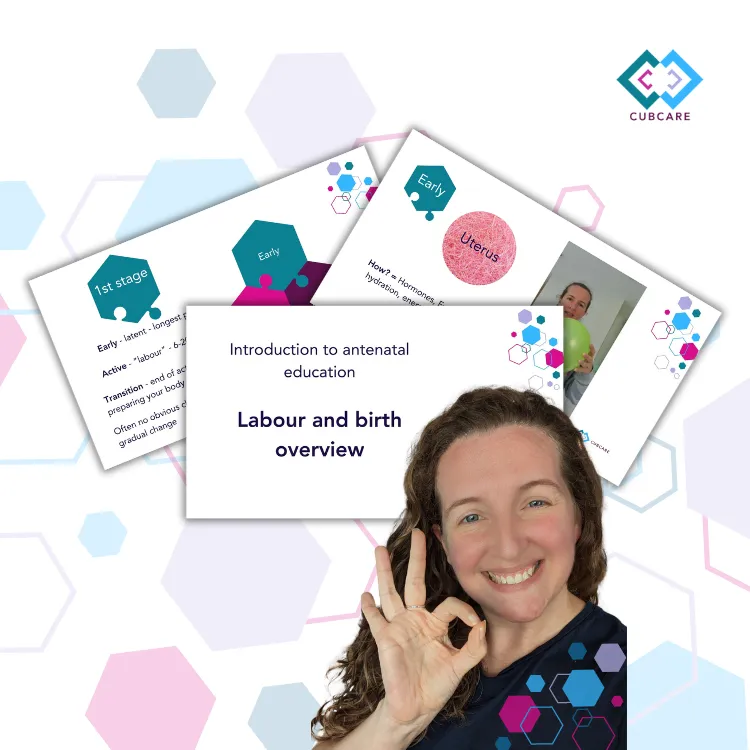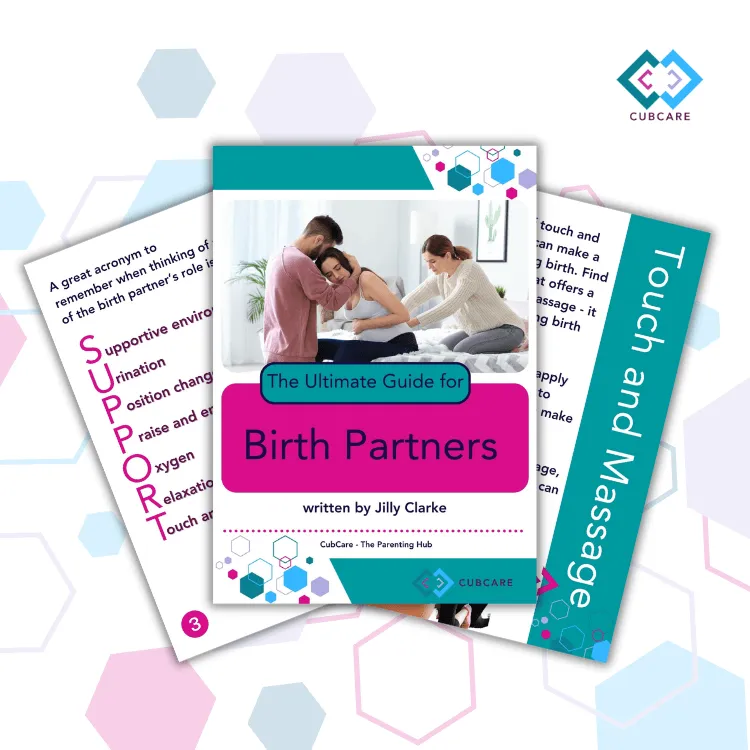We're an award winning Antenatal and Postnatal Education Platform 2025!
(read more here)
CubCare blogs.
From early pregnancy to newborn development.
Advice to help through pregnancy, birth and childhood.
BLOG

How important is the cervix for labour and birth?
“Your cervix is not a crystal ball. It cannot predict when labour will start. Nor can it predict if you will deliver before, after or even on your due date. The cervix can do many wonderful things, but let’s not give the cervix more credit than it is due. A cervix cannot predict the future.”- Maria Pokluda
What is the obsession with cervix dilation
Anyone who has ever watched a film or a television programme depicting birth will likely have heard the term “dilated”. That is, a number in centimetres followed by the word dilated. During labour, if you agree to a vaginal examination, you will likely hear that phrase. And it is easy to get distracted by it and focus on the numbers.
Care providers will often tell you that you are not in labour until a magic mark of 4-5cm dilated. If you consent to vaginal examination during labour you will likely hear a number followed by “dilated”.
But is your cervix dilating important? What can it tell us about labour?
As an antenatal teacher for the past decade, I can tell you that there is often too much emphasis put on the cervix when it comes to labour. We shouldn't be focusing on the numbers of centimetres the cervix has "disappeared", and should be focusing on something much more productive and positive. Like how much power the uterus has developed.

What is the cervix?
The cervix is the exit, or the “neck” of the uterus. It’s job, during pregnancy is to keep everything in place, and to stop anything getting in.
Firstly, the cervix part of the uterus. It acts a little differently in that it needs to go on a journey before it is ready to dilate, and to birth a baby. But, it really helps to think of the uterus and cervix as part of the same organ.
They need to work together.
If you think of them as like a funnel, the cervix is the thinner bit at the bottom.
It is still part of the uterus itself, although it acts differently during pregnancy to make sure that everything stays safe.
At the end of pregnancy, when baby is getting ready to be born, this cervix starts to change, to allow the baby to move down and be born.
“Dilated” is the term for how open the bottom part of the funnel is – baby will be moving down into this bottom section as labour progresses – but it also expands out the way of baby too.

You could think of it like a champagne bottle and its cork
Without the cork the contents of the bottle is open to the air. Flies and bugs could get in.
Before you can get to the good contents inside, the cork needs to be taken out of the bottle. For birth, the cervix doesn’t get released, nor open, but in fact peels back over baby’s head as they move down and becomes part of the uterus.
This allows a big band of muscle to build at the top of the uterus to help give power to birth baby.
Perhaps the champagne and cork analogy isn’t quite correct but it certainly got your attention!?
Is the cervix as important as it is made out to be?
Probably not.
Your cervix does have an important job during your pregnancy and in birth though. There is so much going on with your cervix when preparing for, and in labour. But the focus on the cervix seems to be drawing attention to the wrong place. The medical world will be interested in your cervix, but you should be not giving it a second thought in labour.
We know that birth happens best when we are relaxed.
Things like baby’s positioning, strength and intensity of contractions and how relaxed the birthing person is also play a really important role in birth, and give more information to a midwife than a vaginal examination to check the cervix. It would be very hard for the uterus and the cervix to do their jobs without everything falling into place and working together.
If you agree to a vaginal examination to check your cervix, perhaps instead of focusing on the numbers, ask your midwife not to share the details – or even don’t consent to the examination in the first place (the choice is yours!). There is very little evidence to support the use of vaginal examinations during labour, especially to check how far along labour is. Although a vaginal examination isn’t just to check how dilated you are. Choice is important! As is understanding exactly what is or isn't important during labour.
What does the cervix do?
During pregnancy, your cervix is like thick cartilage (a bit like the end of your nose), closed and plugged with mucus.
It is about two and a half centimetres long, about the distance between the tip of your finger and your second knuckle.
It also starts off pointing towards the back wall of your vagina.
As your body starts getting ready for labour and birth, it will release hormones called ‘prostaglandins’. This hormone starts to change your cervix, to allow the cervix to move out of the way and get it ready for baby to be able to pass through.
These will help it begin to soften, ripen, and do its thing!
As this starts, the mucus plug may also start to come away. Sometimes called a ‘show’, you may notice it in your pants, or when you wipe after going to the toilet. You may also not notice anything, but it will come away at some point.
Then it begins. Your cervix has one heck of a journey to go on and it will start before you even realise you are in labour!
How does the cervix change in labour?
The jobs of your cervix preparing for birth
1. Effacement – how long your cervix is
Effacement is measured in percentages.
We know that the cervix is roughly 2.5cm long during pregnancy. Imagine from your main knuckle on your index finger.
You are about 50% effaced if your cervix only reaches from the tip of the finger to the first knuckle, .
This process must start to happen before dilation can even occur. In many people, it occurs at the same time or it overlaps dilation.
We often see effacement first, then dilation quickly follows. So while you might “still” be 4cm dilated, you may have gone from 50% effaced to 90% effaced!
2. Ripening – softening
Touch the tip of your nose. That’s about the texture of a closed, uneffaced cervix. Imagine birthing a baby through something that hard?
It has to soften, or “ripen” in order to do its other jobs. This primarily starts before labour begins but continues as you progress.
So again, you might “still” be 4cm dilated, but your cervix may have softened from feeling hard to feeling like the inside of your cheek!
3. Position
To protect your baby, your cervix points towards your tailbone (posterior) during pregnancy and is often too far up for a person to feel during examination.
To open and allow the baby to move through it, your cervix must shift its position until it is pointing directly into your vagina (anterior).
4. Dilation
Dilation cannot happen unless the cervix is doing all of its other jobs already. The process often starts before contractions begin. But they often happen seemingly in tandem.
So, someone may be “stuck at 5cm” for a while. But their cervix is effacing, softening, and moving forward and doing all of the other jobs!
How do the cervix and uterus work together in labour?
Thinking back to the idea that the cervix and uterus are the same organ. They need to work together in tandem.
Often all the focus is on the uterus opening the cervix with contractions. What is happening is that the uterus is moving the baby down, whilst bringing tissue from the cervix up into the uterus.
This will create a strong band of muscle at the top of the uterus to expel baby into the world, instead of that hard tissue keeping baby inside.
Another birth expert Carla Hartley says:
“The purpose of labor is NOT the creation of an opening or a hole… The purpose of labor contractions and retractions is to BUILD the fundus, which will, when it is ready, EJECT the baby, like a piston… the cervix does not dilate out….it dilates UP as a result of the effort to pull muscles up into the uterus to push muscles up to the fundus. The cervical dilation is secondary to that. The cervix is pulled up as a result of the building of the fundus.”
So perhaps, instead of thinking how many centimetres there are left to go, you could think how much power is there in the uterus to bring baby out?
How can we give power to these contractions and this uterus?
To help the cervix move out of the way!
But our bodies are SO capable. With the trust, the knowledge and the education you CAN have an amazing birth experience.
That's why we have our Antenatal Course (both in person and online), Refresher Antenatal Course (both in person and online), and our Birth Partner course so that everybody can get knowledgeable and confident for birth.
Refresher Antenatal Course in person
Refresher Antenatal Course online
Birth Partner course (included in our Antenatal course)
Antenatal Course in person
Antenatal Course online
Easily navigate to our most popular Blog categories
Download our Freebies

Labour and Birth
Watch our introduction to antenatal education webinar, our labour and birth overview - to start your antenatal education journey. Understanding the process, and what you can do to influence it.

Pregnancy Planner
Free Pregnancy Planner to help you prepare for a little one. Prepare your body, your mind, your finances and your home. Get organised, feel good and prepare for an active, positive birth.

Birth Partner Guide
Your ultimate guide to being the best birth partner during pregnancy, birth and recovery. Learn what you need to do, and what you need to learn to be the best birth partner possible.

Expecting Again Guide
Your ultimate guide to preparing for another birth and an extra baby. Our top tips for navigating pregnancy and birth, and helping your older ones to transition into their new role as a big sibling.
Based in Welwyn Hatfield, offering local pregnancy support and doula services across Hertfordshire: St Albans, Hatfield, Welwyn Garden City, Potters Bar, Stevenage, Harpenden, Hitchin, Barnet, Mill Hill and surrounding areas.
Online antenatal and postnatal education available UK-wide.
© Copyright 2025 CubCare The Parenting Hub. CubCare is operated by The Birth and Baby Company Ltd. Company No. 15655287
Privacy Policy | Terms & Conditions | Medical Disclaimer | Inclusivity and Accessibility

